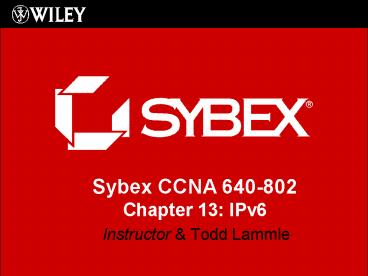Instructor PowerPoint PPT Presentation
1 / 13
Title: Instructor
1
Sybex CCNA 640-802 Chapter 13 IPv6
- Instructor Todd Lammle
2
Chapter 13 Objectives
- The CCNA Topics Covered in this chapter include
- What is IPv6?
- Why do we need IPv6?
- IPv6 Addressing
- Address types
- Special Addresses
- Autoconfiguration
- Configuring IPv6
- Tunneling
2
3
What is IPv6?
- People refer to IPv6 as the next-generation
Internet protocol, and it was originally created
as the answer to IPv4s inevitable, looming
address-exhaustion crisis. - Though youve probably heard a thing or two
about IPv6 already, it has been improved even
further in the quest to bring us the flexibility,
efficiency, capability, and optimized
functionality that can truly meet our
ever-increasing needs.
3
4
Why do we need IPv6?
- Because we need to communicate, and our current
system isnt really cutting it anymorekind of
like how the Pony Express cant compete with
airmail. Just look at how much time and effort
weve invested in coming up with slick new ways
to conserve bandwidth and IP addresses. - The amount of people and devices that connect to
networks increases each and every day.
4
5
IPv6 Addressing
IPv6 addresses are 128 bits
5
6
Shortened Expression
You can actually leave out parts of the address
to abbreviate it, but to get away with doing that
you have to follow a couple of rules. First, you
can drop any leading zeros in each of the
individual blocks. After you do that, the sample
address from earlier would then look like
this 2001db83c4d1200123456ab Okay, thats
a definite improvementat least we dont have to
write all of those extra zeros! But what about
whole blocks that dont have anything in them
except zeros? Well, we can kind of lose those
tooat least some of them. Again referring to our
sample address, we can remove the two blocks of
zeros by replacing them with double colons, like
this 2001db83c4d12123456ab
6
7
Address Types
- Unicast
- Global Unicast
- Link-local
- Unique Local
- Multicast
- Anycast
7
8
Special Addresses
00000000 Equals . This is the
equivalent of IPv4s 0.0.0.0, and is typically
the source address of a host when youre using
stateful configuration. 00000001
Equals 1. The equivalent of 127.0.0.1 in
IPv4. 000000192.168.100.1 This is how an
IPv4 address would be written in a mixed
IPv6/IPv4 network environment. 2000/3 The
global unicast address range. FC00/7 The
unique local unicast range. FE80/10 The
link-local unicast range.
8
9
Special Addresses Cont.
FF00/8 The multicast range. 3FFFFFFF/32
Reserved for examples and documentation. 20010D
B8/32 Also reserved for examples and
documentation. 2002/16 Used with 6to4, which
is the transition systemthe structure that
allows IPv6 packets to be transmitted over an
IPv4 network without the need to configure
explicit tunnels.
9
10
Autoconfiguration
10
11
Configuring IPv6
In order to enable IPv6 on a router, you have to
use the ipv6 unicast-routing global configuration
command Corp(config)ipv6 unicast-routing IPv6
isnt enabled by default on any interfaces
either, so we have to go to each interface
individually and enable it. You use the interface
configuration command ipv6 address
ltipv6prefixgt/ltprefix-lengthgt eui-64to get this
done. Heres an example Corp(config-if)ipv6
address 2001db83c4d10260.d6FF.FE73.1987/64 Yo
u can specify the entire 128-bit global IPv6
address or you can use the eui-64 option.
Remember, the eui-64 format allows the device to
use its MAC address and pad it to make the
interface ID. Corp(config-if)ipv6 address
2001db83c4d1/64 eui-64
11
12
Tunneling 6to4
12
13
Written Labs and Review Questions
- Open your books and go through all the written
labs and the review questions. - Review the answers in class.
13

